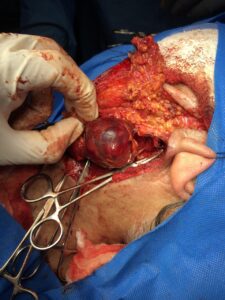Succesfull three ports laparoscopic cholecystectomy for left sided gallbladder in female patient with situs inversus totalis (Sep. 2018)
Case presentation
32 years old female patient known case of situs inversus totalis presented with left upper quadrant abdominal pain referred to the left shoulder. Abdominal examination: Tender left hypochondria with positive Murphy’s sign. Abdominal Ultrasound reveals situs inversus totalis with left sided acute calculus cholecystitis.
Blood tests revealed normal haematolgical and biochemical results.
The patient put on medical treatment and she responded well within 2 weeks.
The patient advised to do laparoscopic cholecystectomy after another 2 weeks. Successful 3 ports laparoscopic cholecystectomy done with difficulty due to thickened and inflamed gallbladder wall and it’s left position that makes dissection and manipulation difficult to right handed surgeon.
After more than 1750 laparoscopic cholecystectomies , this is the first case to me. It was really different from usual right sided laparoscopic cholecystectomy. The patient discharged in the next day with smooth postoperative course.
Review of literature
Laparoscopic cholecystectomy in situs inversus totalis: Feasibility and review of literature
Ibrahim Abdelkader Salama,a,⁎ Mohammed Hussein Abdullah,b and Mohammed Housenic
Author information ► Article notes ► Copyright and License information ► Disclaimer
This article has been cited by other articles in PMC.
Abstract
INTRODUCTION
Situs inversus totalis is a rare anomaly characterized by transposition of organs to the opposite site of the body. Laparoscopic cholecystectomy in those patients is technically more demanding and needs reorientation of visual-motor skills to left upper quadrant.
PRESENTATION OF CASE
Herein, we report a 10 year old boy presented with left hypochondrium and epigastric pain 2 months duration. The patient had not been diagnosed as situs inversus totalis before. The patient exhibit a left sided “Murphy’s sign”. Diagnosis of situs inversus totalis was confirmed with ultrasound, computerized tomography (CT) and magnetic resonant image (MRI) with presence of multiple gall bladder stones with no intra or extrabiliary duct dilatation. The patient underwent laparoscopic cholecystectomy for cholelithiasis.
DISCUSSION
Feasibility and technical difficulty in diagnosis and treatment of such case pose challenge problem due to the contra lateral disposition of the viscera. Difficulty is encountered in skelatonizing the structures in Calot’s triangle, which consume extra time than normally located gall bladder. A summary of additional 50 similar cases reported up to date in the medical literature is also presented.
CONCLUSION
Laparoscopic cholecystectomy is feasible and should be done in situs inversus totalis by experienced laparoscopic surgeon, as changes in anatomical disposition of organ not only influence the localization of symptoms and signs arising from a diseased organ but also imposes special demands on the diagnosis and surgical skills of the surgeon.
Keywords: Situs inversus totalis-cholelithiasis, Laparoscopic cholecystectomy



